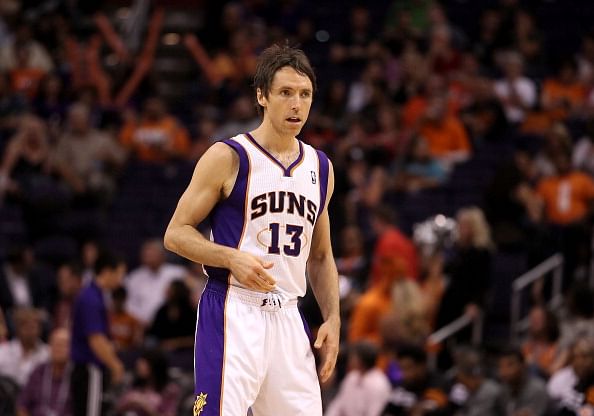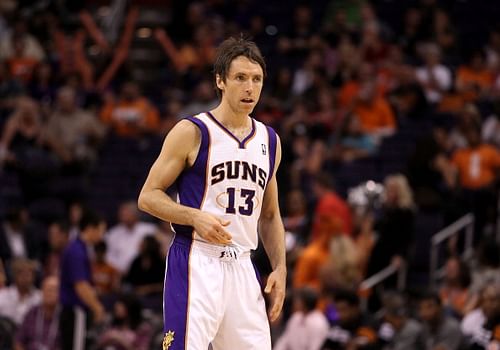
Rising Suns
Call it a solar eclipse, or call it a shadow hanging over the Sun, but even before the 2012-13 Phoenix Suns play a single game, a giant shadow of one of their smallest ex-players will hover above them. Even with the player gone, his shadow will follow them and define them, and the only way to escape the shadow will be for the Suns to shine bright without him.
That player is Steve Nash.

Nash – all 6 foot 3 inches of him – is responsible for making the Suns everything they were in the past decade. Between 2004-2012, he carried them to the playoffs eight times, helped them become one of the top teams in the Western Conference, and became the mastermind point guard as he made them one of the most exciting basketball squads in NBA history. Nash ran and ran and ran, always thinking ahead, always offense, always finding more and more points, always sharing the ball, and the Suns ran and shot and passed and scored with him. Sharing the stage in his tenure with the likes of Amar’e Stoudemire, Shaun Marion, Joe Johnson, Quentin Richardson, Boris Diaw, Jason Richardson, and Shaquille O’Neal, Nash made the Suns lovable. He won two MVP awards in the process and led the league in assists five times in eight years.
Even at the age of 38, Nash led a now-weakened squad last season close to the playoffs again. He was again one of the league’s leaders in assists, even though there was no one else in his team who was a better offensive option than himself. The best talent around him was Marcin Gortat, Jared Dudley, and Channing Frye. And even though they weren’t rising any longer, they were still Nash’s team, and they were still the shining, lovable Suns.
 But every golden era has its end, and the ‘Nashty Suns’ project existed way beyond their expiration date. A fresh start was needed. Nash was sent to the Lakers for a last chance to win the elusive championship ring. Another former-superstar old man – Grant Hill – left Phoenix too with hopes to see of his career in the Clipper side of Los Angeles. And so, the Suns got a chance to rise like a phoenix and be reborn, as a new team, a new rising sun, and redefine themselves away from the shadow of the Nash years.
But every golden era has its end, and the ‘Nashty Suns’ project existed way beyond their expiration date. A fresh start was needed. Nash was sent to the Lakers for a last chance to win the elusive championship ring. Another former-superstar old man – Grant Hill – left Phoenix too with hopes to see of his career in the Clipper side of Los Angeles. And so, the Suns got a chance to rise like a phoenix and be reborn, as a new team, a new rising sun, and redefine themselves away from the shadow of the Nash years.
To do that, the Suns have brought in several new players. One of the marquee names on the list is Argentinian power-forward Luis Scola. Grossly underrated for the past few years, Scola has been quietly been a force out in Houston, averaging 14.5 ppg and 7.7 rpg in a team where he started off as a role player and quietly developed into a reliable top option. The Rockets loss was the Suns gain, as Phoenix snapped up the free agent who immediately bolsters up their frontcourt. Scola has been a star for Argentina’s national squad for several years, and in the right system, can blossom into an NBA All Star, too.
Joining him in the post will be Marcin Gortat, the Polish Center who has absolutely thrived in Phoenix with Nash as his point guard. Gortat arrived in Phoenix as a supplementary piece to Vince Carter from Orlando, but he quickly developed into a player far more important than ‘Vinsanity’ to the Suns system. He quietly averaged 15.4 ppg and 10 rebounds a game running pick and rolls with Steve Nash last season. But Nash has been the NBA’s best point guard over the last decade and can make even the worst of players useful. It’s unlikely that Gortat will continue to be super-productive without him. But he is still a decent player, and in a league short of superstar Centers, he can combine with Scola to make the Suns a rarity in today’s NBA: a team with an imposing offensive post presence.
The days of Nash running-and-gunning with a reliable three-point threat are long gone: the keys to the Suns’ backcourt has now been handed to the young man hoping to be Nash’s long-term replacement at the point guard position – Goran Dragic. The Slovenian immediately adds to the new international flavour of the Suns, and returns to the team with whom he started his career after two years in Houston. Dragic played backup to Nash for three years before heading to Houston where he had a semi-impressive showing last season, posting a career-high 11.7 ppg in career high 26 minutes per game. An injury to Kyle Lowry gave Dragic a chance to become a regular starter, and he will return to Phoenix with a new-found confidence to start from day one. No one is expecting Dragic to produce the magic of Nash, but it is in him whom the new-look Suns now place their faith at the point.
Dragic will likely be accompanied in the starting backcourt role with Jared Dudley. Dudley is at best an average player at his position, and can be added to the long list of players who can credit Steve Nash in helping him average a career high in points (12.7 ppg last season).
But in no way is his starting role assured. Challenging him at the spot will be newly-signed Wesley Johnson and former Laker/Nett Shannon Brown. The Suns have a few more exciting names beefing up their bench. Rookie Kendell Marshall from North Carolina could be a steal of the 2012 draft at 13th and will provide healthy challenge to Dragic for the starting point guard spot. NBA journeyman Sebastian Telfair, Channing Frye, and veteran Center Jermaine O’Neal are also in the squad.
 But all of this average-ness in Phoenix can – at best – only add up to an average squad, and average squads don’t make the playoffs in the ever-competitive Western Conference. Starting at small forward could be their one wild card, a player who can either elevate them to greater heights or bring them down to miserable lows. If his inclusion in the squad works out, he could become the face of the franchise after Nash. And if it doesn’t work, Phoenix could end up becoming just one more stop in his underwhelming career.
But all of this average-ness in Phoenix can – at best – only add up to an average squad, and average squads don’t make the playoffs in the ever-competitive Western Conference. Starting at small forward could be their one wild card, a player who can either elevate them to greater heights or bring them down to miserable lows. If his inclusion in the squad works out, he could become the face of the franchise after Nash. And if it doesn’t work, Phoenix could end up becoming just one more stop in his underwhelming career.
Michael Beasley.
Four years into his NBA career, and Beasley has achieved little in Miami or in Minnesota that earned him superstar hype back in 2008 and a second place draft-pick, only behind Derrick Rose. Sure, he made the All Rookie First Team in his rookie season and averaged over 19 points per game for Minnesota in 2010-11, but in a super-competitive league, those achievements are relatively nothing for a player who was once destined for greatness. An effortless, ambidextrous scorer with a dangerous offensive arsenal and the ability to play both forward positions, Beasley was supposed to follow in the footsteps of other recent great scorers like Carmelo Anthony and Kevin Durant. Instead, a range of foolish and immature decisions, a whole lotta weed smoked, and a general lack of competitive spirit has made his former college superstar into nothing more than a player destined to be above average for below average teams.
But at 23, Beasley is still young, and there is still a lot of time left in his career for him to change his attitude and perfect his game, on both ends of the floor. The Suns will be hoping that he can live up to his once-starry potential again. And even if he doesn’t become a superstar that he was once destined to be, he can still develop into a lethal scorer whom they added to their squad at a bargain. What they will not hope to see is to find Beasley bring with him the negativity and attitude problems that frustrated his previous teams, the kind of locker-room negativity that could bring down other players with him.
Whatever happens in Phoenix, the franchise can at least be certain that they are heading into the post-Nash era with some optimism and new personality in their roster. Time will tell if this new team can gel together without an All Star leader. The Sun may have set on the Nash-era, but it will be up to these new faces to make sure a new sun confidently rises in Phoenix again.